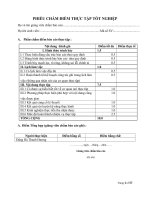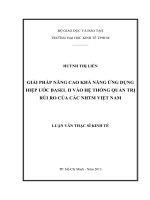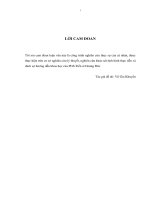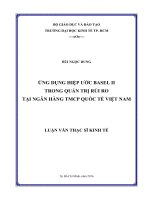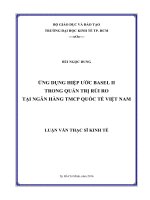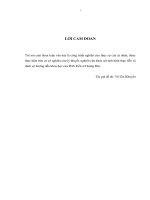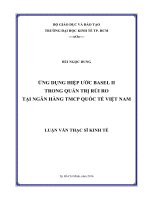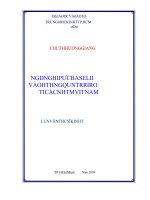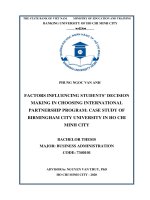Ứng dụng hiệp ước basel II vào hệ thống quản trị rủi ro tại ngân hàng TMCP công thương việt nam
Bạn đang xem bản rút gọn của tài liệu. Xem và tải ngay bản đầy đủ của tài liệu tại đây (1.94 MB, 131 trang )
THE STATE BANK OF VIET NAM
MINISTRY OF EDUCATION AND TRAINING
BANKING UNIVERSITY OF HO CHI MINH CITY
_____ _____
PHUNG NGOC VAN ANH
FACTORS INFLUENCING STUDENTS’ DECISION
MAKING IN CHOOSING INTERNATIONAL
PARTNERSHIP PROGRAM: CASE STUDY OF
BIRMINGHAM CITY UNIVERSITY IN HO CHI
MINH CITY
BACHELOR THESIS
MAJOR: BUSINESS ADMINISTRATION
CODE: 7340101
ADVISOR by NGUYEN VAN THUY, PhD
HO CHI MINH CITY - 2020
THE STATE BANK OF VIET NAM
MINISTRY OF EDUCATION AND TRAINING
BANKING UNIVERSITY OF HO CHI MINH CITY
_____ _____
PHUNG NGOC VAN ANH
FACTORS INFLUENCING STUDENTS’ DECISION
MAKING IN CHOOSING INTERNATIONAL
PARTNERSHIP PROGRAM: CASE STUDY OF
BIRMINGHAM CITY UNIVERSITY IN HO CHI
MINH CITY
BACHELOR THESIS
MAJOR: BUSINESS ADMINISTRATION
CODE: 7340101
ADVISOR by NGUYEN VAN THUY, PhD
HO CHI MINH CITY - 2020
i
ABSTRACT
In the current competitive environment, each institution must investigate into
the consideration of potential students when making the decision to choose a
particular program. The theoretical background has provided some practical models
regarding the consequential stages that prospective students would adopt through
the decision making in choosing the international partnership program of
Birmingham City University in Ho Chi Minh City. Within their consideration set,
students who participate in this decision making process will compare between a
number of alternatives and choose the institution with the greatest value and various
benefits. The research attempts to figure out the relationship as well as the impact
levels of five main factors on students’ decision making to promote the efficiency of
school admission policy and lead to the better performance of international
partnership programs in the education system. The survey was conducted with the
participation of 350 students from BCU program.
The findings show that all of the factors have a positive correlation with
students’ decision making, which means that focusing on a number of components
that can bring up the best outcomes can give BCU itself an overwhelming
advantage compared to other rivals in the market. After analysis, the levels of
impact factors in descending orders are: institutional characteristics - reference
groups - communication effort - personal attributes - contextual factors. The results
of T-test and ANOVA show no difference between different genders or age groups
in terms of students’ decision making. In particular, BCU program should focus on
updating the latest majors that suit students’ interests and aspirations as well as
improving the teaching quality. BCU program should also consider providing
financial support or scholarships for prospective students, which may give it a great
advantage compared to other programs. Online and offline marketing are also
potential aspects that BCU program can invest in to attract students’ attention as
well as their parents – who have shown a strong impact on the students’ final
decisions.
ii
DECLARATION
The thesis entitled “Factors influencing students’ decision making in choosing
international partnership program: Case study of Birmingham City University in Ho
Chi Minh City” is conducted by me under the supervision of Nguyen Van Thuy,
Ph.D in the Department of Business Administration.
I declare that the information reported in this graduate thesis is the result of
my work, except where due to reference is made. It is not written or published
anywhere else. The thesis has not been accepted for any degree and is not submitted
to any candidature for any other degree or diploma.
Ho Chi Minh City, …./…./ 2020
Signature
Phùng Ngọc Vân Anh
iii
ACKNOWLEDGEMENT
I could not have completed my thesis successfully without the greatest support
of my beloved ones. I would like to express my deepest gratitude towards:
Banking University and my lecturers – for providing me with the best
conditions as well as valuable knowledge during my academic years, which help me
a lot during the implementation of this research.
Mr. Nguyen Van Thuy – who is my advisor for always being by my side,
devoting your precious time to help me out with my thesis. Thanks to your precise
instruction and detailed comments on my work, I have completed my graduate
thesis with the best effort.
My family and friends – who always show your wholehearted support for me
throughout my time doing this research, which makes it memorable and grateful for
me through thick and thin.
iv
TABLE OF CONTENT
ABSTRACT ....................................................................................................... i
DECLARATION ................................................................................................. ii
ACKNOWLEDGEMENT .................................................................................. iii
TABLE OF CONTENT ...................................................................................... iv
LIST OF ABBREVIATIONS ........................................................................... viii
LIST OF TABLES .............................................................................................. ix
LIST OF FIGURES ............................................................................................. x
CHAPTER 1: INTRODUCTION ........................................................................ 1
1.1. Research problem statement ................................................................... 1
1.2. Research objectives ................................................................................ 2
1.3. Research questions .................................................................................. 3
1.4. Research subject and scope .................................................................... 3
1.5. Research methodology............................................................................ 3
1.6. Research contribution ............................................................................. 4
1.7. Thesis structure ....................................................................................... 4
SUMMARY OF CHAPTER 1 ...................................................................... 5
CHAPTER 2: LITERATURE REVIEW ............................................................. 6
2.1. Definition ................................................................................................ 6
2.1.1. Decision making .............................................................................. 6
2.1.1.1. Definition of decision making ................................................ 6
2.1.1.2. Characteristics of decision making ........................................ 7
2.1.2. Partnership program......................................................................... 8
2.1.2.1. Definition of partnership program.......................................... 8
2.1.2.2. Characteristics of partnership program .................................. 8
2.1.2.3. Forms of partnership program ................................................ 9
v
2.1.2.4. Key elements of partnership program .................................... 9
2.2. Literature review ................................................................................... 10
2.2.1. Theoretical background ................................................................. 10
2.2.1.1. The garbage can model (Cohen, March, and Olsen, 1972) .. 10
2.2.1.2. Theory of planned behavior (Ajzen and Fishbein ,1975) .... 11
2.2.1.3. The rational model (Simon, 1977) ....................................... 13
2.2.1.4. The model of bounded rationality (Simon, 1979) ................ 14
2.2.1.5. Customer buying decision process (Kotler, 1997) ............... 15
2.2.1.6. The recognition‑primed decision model (Klein, 1998) ........ 17
2.3. Previous researches ............................................................................... 19
2.4. Conceptual model and hypotheses........................................................ 33
2.4.1. Variable selection .......................................................................... 33
2.4.2. Research hypotheses ...................................................................... 34
2.4.3. Research conceptual model ........................................................... 41
SUMMARY OF CHAPTER 2 .................................................................... 41
CHAPTER 3: RESEARCH METHODOLOGY ............................................... 43
3.1. Research process ................................................................................... 43
3.2. Scale development process ................................................................... 44
3.3. Developing scale ................................................................................... 45
3.3.1. Personal attributes .......................................................................... 45
3.3.2. Institutional characteristics ............................................................ 46
3.3.3. Communication effort .................................................................... 47
3.3.4. Reference groups ........................................................................... 48
3.3.5. Contextual factors .......................................................................... 49
3.3.6. Students’ decision making ............................................................. 50
vi
3.4. Sample size ........................................................................................... 51
3.5. Questionnaire design ............................................................................ 51
3.6. Data analysis methods .......................................................................... 52
3.6.1. Descriptive statistics ...................................................................... 52
3.6.2. Cronbach’s Alpha .......................................................................... 52
3.6.3. Exploratory Factor Analysis (EFA) ............................................... 53
3.6.4. Linear regression ........................................................................... 55
3.6.5. Independent samples T-test and One-way ANOVA ..................... 56
SUMMARY OF CHAPTER 3 .................................................................... 57
CHAPTER 4: FINDINGS AND DISCUSSIONS ............................................. 58
4.1. Overview of BCU international partnership program .......................... 58
4.2. Descriptive statistics ............................................................................. 58
4.3. Results of data analysis ......................................................................... 61
4.3.1. Cronbach’s Alpha coefficient ........................................................ 61
4.3.2. Exploratory Factor Analysis (EFA) ............................................... 64
4.3.3. Pearson’s correlation coefficient ................................................... 66
4.3.4. Result of multiple regression analysis ........................................... 66
4.3.5. Result of hypothesis testing ........................................................... 69
4.3.6. T-Test ............................................................................................. 70
4.3.7. One - way ANOVA test ................................................................. 70
4.4. Summary of results ............................................................................... 70
SUMMARY OF CHAPTER 4 .................................................................... 72
CHAPTER 5: CONCLUSIONS AND IMPLICATIONS ................................. 73
5.1. Conclusion ............................................................................................ 73
5.2. Implications .......................................................................................... 74
vii
5.2.1. Implications of “Personal attributes” ............................................. 74
5.2.2. Implications of “Institutional characteristics” ............................... 76
5.2.3. Implications of “Communication effort” ....................................... 77
5.2.4. Implications of “Reference groups” .............................................. 78
5.2.5. Implications of “Contextual factors” ............................................. 79
5.3. Limitations and recommendations ........................................................ 80
SUMMARY OF CHAPTER 5 .................................................................... 81
REFERENCES .................................................................................................. 82
APPENDIX 1. FOCUS GROUP DISCUSSION (ENGLISH VERSION) ....... 87
APPENDIX 2: FOCUS GROUP DISCUSSION (VIETNAMESE VERSION) 91
APPENDIX 3: QUESTIONNAIRE (ENGLISH VERSION) ........................... 95
APPENDIX 4: QUESTIONNAIRE (VIETNAMESE VERSION) ................. 100
APPENDIX 5: DESCRIPTIVE STATISTICS ................................................ 105
APPENDIX 6: CRONBACH’S ALPHA COEFFICIENT .............................. 106
APPENDIX 7: EXPLORATORY FACTOR ANALYSIS (EFA) .................. 109
APPENDIX 8: PEARSON’S CORRELATION COEFFICIENT ................... 111
APPENDIX 9: MULTIPLE REGRESSION ANALYSIS .............................. 112
APPENDIX 10: T-TEST ................................................................................. 113
APPENDIX 11: ONE - WAY ANOVA TEST ............................................... 114
APPENDIX 12: MEAN TEST ........................................................................ 115
APPENDIX 13: DETECTING VIOLATIONS OF ASSUMPTIONS ............ 117
viii
LIST OF ABBREVIATIONS
Abbreviation
Definition
AB
Attitude toward behavior
ANOVA
Analysis of variance
BCU
Birmingham City University
CE
Communication effort
CF
Contextual factors
EFA
Exploratory factor analysis
GCM
Garbage can model
GDP
Gross domestic product
IC
Institutional characteristics
KMO
Kaiser – Meyer – Olkin
PA
Personal attributes
PBC
Perceived behavioral control
RG
Reference groups
RPD
Recognition – primed decision model
SDM
Students’ decision making
SN
Subjective norm
SPSS
Statistical Package for the Social Sciences
UAE
United Arab Emirates
ULAB
University of Liberal Arts
VND
Vietnamese Dong
VU
Varendra University
ix
LIST OF TABLES
Table 2.1. Summary of previous researches .................................................... 30
Table 2.2. Variable selection ........................................................................... 33
Table 3.1. Research process ............................................................................. 43
Table 3.2. The scale of “Personal attributes” .................................................. 46
Table 3.3. The scale of “Institutional characteristics” ..................................... 47
Table 3.4. The scale of “Communication effort” ............................................ 48
Table 3.5. The scale of “Reference groups” .................................................... 48
Table 3.6. The scale of “Contextual factors” ................................................... 49
Table 3.7. The scale of “Students’ decision making” ...................................... 50
Table 4.1. Results of descriptive statistics ....................................................... 59
Table 4.2. Results of reliability test ................................................................. 61
Table 4.3. Results of EFA analysis .................................................................. 65
Table 4.4. Results of Pearson’s Correlation .................................................... 66
Table 4.5. Model Summaryb ............................................................................ 66
Table 4.6. Coefficientsa.................................................................................... 67
Table 4.7. Hypotheses verification .................................................................. 69
Table 5.1. Descriptive statistics results of "Personal attributes" ..................... 75
Table 5.2. Descriptive statistics results of “Institutional characteristics” ....... 76
Table 5.3. Descriptive statistics results of “Communication effort” ............... 77
Table 5.4. Descriptive statistics results of “Reference groups” ...................... 78
Table 5.5. Descriptive statistics results of “Contextual factors” ..................... 79
x
LIST OF FIGURES
Figure 2.1.The garbage can model .................................................................. 11
Figure 2.2. Theory of planned behavior .......................................................... 12
Figure 2.3. The rational model ........................................................................ 14
Figure 2.4. 3-stage decision making process ................................................... 14
Figure 2.5. The bounded rationality model ..................................................... 15
Figure 2.6. Customer buying decision process ................................................ 17
Figure 2.7. The recognition‑primed decision model ....................................... 19
Figure 2.8. Conceptual model of “Factors that influence the university choice
of high school students” ........................................................................................... 20
Figure 2.9. Conceptual model of “Factors influencing the decision making in
choosing Tien Giang University of high school students in Tien Giang province” 21
Figure 2.10. Conceptual model of “Factors influencing the education decision
making process” ....................................................................................................... 22
Figure 2.11. Conceptual model of “Factors influencing the decision making to
choose an international training program at University of Economics – Hue” ....... 23
Figure 2.12. Conceptual model of “Factors evaluate students’ choice of
programs in the faculty of renewable natural resources of University for
Development Studies, Nyankpala Campus-Ghana” ................................................. 24
Figure 2.13. Conceptual model of “Factors that influence undergraduate
students’ choice of a university: A case of Botho University in Botswana” ........... 25
Figure 2.14. Conceptual model of “Factors that influence the students'
decision to choose a bachelor’s degree program of Banking Academy” ................. 26
Figure 2.15. Conceptual model of “Factors influencing university choice of
high school students in Ha Noi” ............................................................................... 27
Figure 2.16. Conceptual model of “Factors that influence the decision-making
to choose a program of new students in Business Administration faculty” ............. 28
Figure 2.17. Conceptual model of “Factors influencing students’ decision
making in selecting university in Bangladesh” ........................................................ 29
xi
Figure 2.18. Conceptual model of “Factors influencing students’ decision
making in choosing international partnership program: Case study of Birmingham
City University in Ho Chi Minh City” ..................................................................... 41
Figure 3.1. Scale development process............................................................ 45
1
CHAPTER 1: INTRODUCTION
1.1. Research problem statement
Since the past, education has played an important role in the process of
national construction and development. Education is the main channel to distribute
knowledge. The knowledge base is developed through an elaborate and systematic
process of education and training. In addition, education is considered as a major
industrial production since education helps to develop and train the workforce for
the country. The efficient workforce will contribute to the GDP growth rate and
process the approach to industrialization and modernization in socialist
countries. As the immense value of the educational products is to fulfill the demand
of society, education comprehensively affects and leads to the growth of the
national economy.
Throughout the country’s development, education in Vietnam has made
significant progress. According to the statistics of Ministry of Education and
Training, Vietnam’s education system has 235 universities with more than 500
international partnership programs collaborating with other universities all around
the world. At present, most universities are turning into autonomy mechanisms
whereby they have the initiative for attracting, screening, and selecting candidates.
However, the massive establishment of school systems along with the declining
demand of students has put many universities under high pressure. Student
recruitment, therefore, is facing more and more challenges.
As an understanding of students’ decision making has become a primary part
of effective strategic enrollment management, many researches were conducted to
determine factors that influence students’ decision making in choosing education
programs. Some studies have examined the impact of various decision aids on the
satisfaction with the decision-making process or how imminence of commitment
affects the process itself (Wright and Kriewall, 1980). Chapman (1981) stated that
students’ decision making is mainly influenced by personal characteristics along
with a number of external factors. In particular, internal variables relate to the
aspects of students’ achievement and their aspiration while external variables refer
to the outside influences such as family, teachers or friends. Krone et al. (1981)
2
claimed that the most important criteria that people use when making a decision are
concerned with career progression and development. Moreover, James et al. (1999)
identified a range of factors influencing educational decision making including:
reputation, satisfaction, job opportunities, teaching quality, and available courses.
The research of Somers et al. (2006) implied that students apply economic and
sociological theoretical frameworks to evaluate the alternatives when making
decisions. Nick Foskett et al. (2006) found that students consider social factors as
well as financial conditions quite carefully before making their decisions. These
factors include job opportunities, accommodation costs, and proximity. Within the
same area, Shah et al. (2013) proposed that students’ perceptions, job opportunities
and learning environments are the most important.
In the increasingly competitive market, students have a variety of choices
among a wide range of universities and programs with distinctive fields and
occupations. As the state universities still take priority, it has left a heavy burden on
many international partnership programs in our country. Each institution tries to
gain its competitive advantages by a better understanding of the information search
process and key characteristics that most students have when making their decisions
to develop a well-designed strategy to fulfill the learners’ needs. By figuring out
factors that influence the students’ decision making, BCU international partnership
program in particular together with other partnership programs can propose
effective solutions for the admission policy, which leads to a considerable
improvement in the institutional performance and a significant rise in the school
enrollment rates. Moreover, there are still few researches that specifically focus on
that aspect of international partnership programs so the author decides to carry out
the research as “Factors influencing students’ decision making in choosing
international partnership program: Case study of Birmingham City University in
Ho Chi Minh City” with the desire that results drawn from this research can help to
enhance the efficiency in the admissions of partnership programs in the region.
1.2. Research objectives
The general objective of this research is to identify factors influencing the
students’ decision making to choose the BCU international partnership program.
3
The specific objectives of this research: (i) is to verify factors influencing the
students’ decision making in choosing BCU international partnership program by
referring to the conceptual models in the previous researches, (ii) is to measure and
evaluate the influence of these factors on students’ decision making to choose BCU
international partnership program, (iii) is to discuss and provide managerial
implications based on research results then propose effective solutions for the
admission policy to attract more students to BCU international partnership program
in particular and other partnership programs in general.
1.3. Research questions
Questions 1: Which factors can influence students’ decision making to choose
the international partnership program of BCU international partnership program?
Question 2: How do these factors impact on students’ decision making to
choose BCU international partnership program?
Question 3: What are the possible solutions for improving the efficiency in the
admissions of BCU international partnership program and other programs in the
future?
1.4. Research subject and scope
The subject of this study are factors influencing students’ decision making in
choosing international partnership program of Birmingham City University in Ho
Chi Minh City.
The research intends to survey 350 students from the international partnership
program of Birmingham City University with University of Economics & Law and
University of Information Technology in Ho Chi Minh City. Research takes place
over two and a half months (from April to July - 2020).
1.5. Research methodology
In this research, the qualitative research methods were used in posing research
problems, writing a literature review and developing a conceptual model based on
the previous researches, and in group discussion.
The quantitative research methods were applied to the determination of sample
size and population, data sampling, data screening, data analysis and managerial
implications. A 5-point Likert scale was used in designing questionnaires for data
4
collection. Collected data were analyzed by using SPSS 22.0, which includes:
descriptive statistical analysis, Cronbach’s Alpha analysis, exploratory factor
analysis (EFA), linear regression analysis, T-test and One-way ANOVA.
1.6. Research contribution
The research was conducted in order to re-test the conceptual framework
proposed by the previous researches and author’s recommendation. The research
also contains the specific information in reference to the factors influencing
students’ decision making in choosing BCU partnership programs, thereby offering
solutions to promote the efficiency of school admission policy and leading to the
better performance of international partnership programs in the education system.
By the administrative implications drawn from the study, the programs can evaluate
the impact of each factor group and take the necessary steps for future development.
1.7. Thesis structure
Chapter 1: Introduction
Chapter 1 introduces an overview of the topic (the proposed problem and the
necessity to carry out the research), research objectives and questions, research
subject and scope, research methodology, research contribution, and thesis
structure.
Chapter 2: Literature review
In chapter 2, the research presents the definitions of terms used in the research
(including decision making and partnership program) and the theoretical
background related to the research topic (based on the previous researches), then
comes to the overview of previous researches in terms of educational decision
making, thereby analyzing the gaps in previous researches to focus on solving. Next
the conceptual model of this research is presented along with the hypotheses used to
determine the impact of these factors on students’ decision making at BCU
program.
Chapter 3: Research methodology
Chapter 3 mentions the process of conducting the research, how to determine
the sample size, the design of questionnaire, the scale construction (including the
5
scale development process and the official research scale), and the methods of data
analysis in quantitative research.
Chapter 4: Findings and discussions
This chapter presents and discusses the results of the data analysis, used
Statistical Package for the Social Sciences software (SPSS 22.0). The methods used
for analyzing the collected data include: descriptive statistical analysis, Cronbach's
Alpha analysis, exploratory factor analysis (EFA), linear regression analysis, T-test
and One-way ANOVA. At the end, there is the summary of the research results.
Chapter 5: Conclusions and recommendations
This chapter draws conclusions from the findings obtained through the
research, provides the managerial implications and indicates the limitations as well
as the directions for future researches.
SUMMARY OF CHAPTER 1
In chapter 1, the research mainly focuses on giving an overview of the
research problem (the reasons for choosing the topic, the objectives and questions,
research subject and scope). Moreover, the statistical methods which would be used
for sampling and data analysis are also presented. Finally, the research implies on
the contribution that it can make in both theoretical and practical ways, and
introduces the thesis structure.
6
CHAPTER 2: LITERATURE REVIEW
2.1. Definition
2.1.1. Decision making
2.1.1.1. Definition of decision making
Decision making is a continuous process in human life, whereby participating
in this process is classified as a common feature of each individual. The aim of
decision making is to direct human manner and commitment under certain
circumstances towards a future goal. As people make effort and spend time on
reaching their final decisions, they are likely to take part in different types of
decision making. Plans and strategies are developed through decision making.
Under careful planning, vital things are being considered like what-how-when-why
the action will be performed. In order to respond to all of these questions, each
individual has a number of options. When a person picks out the best alternative
from many available ones, it is called decision and the process that has been carried
out to reach the final decision is known as decision-making.
There are some definitions in terms of decision making, which were brought
out by many researchers all around the world.
The book of “Organizational
decision making” by Shull Fremont et al. (1970) pointed out that “Decision-making
is a conscious and human process, involving both individual and social
phenomenon based upon factual and value premises, which concludes with a choice
of one’s behavioral activity from one or more alternatives with the intention of
moving towards some desired state of affairs.” J.W. Duncan (1973) announced that
“A decision is a conscious choice to behave or think in a particular way in a given
set of circumstances. When a choice has been made and a decision has been arrived
at, decision making is a process of choosing a course of action from two or three
alternatives.”
According to George R. Terry and Stephen G. Franklin (1974), “Decisionmaking is the selection based on some criteria from two or more possible
alternatives”. Sharing the same view, John Clifton Williams (1985) implied that “A
decision is the selection of a course of action from two or more alternatives; the
decision-making process is a sequence of steps leading to that selection”. Kotler
7
(1997) mentioned that decision making would be classified as an “extensive
problem solving” with the complexity and variety of choices involved. Decisionmaking is considered by Andrew Smilagyi (1998) as a process involving
information, choices among alternative courses of action, implementations, and
evaluation that is directed to the achievement of certain stated goals. Robert
Kreitner (2005) stated that “Decision-making is a process of identifying and
choosing alternative courses of action in a manner appropriate to the demand of the
situation. The act of choosing implies the alternative courses of action must be
weighted and weeded out.”
In conclusion, decision making is a cognitive process implemented by a
decision-maker to make choices by setting goals, identifying and evaluating various
alternatives. Decision-making takes place in achieving the objectives and selecting
appropriate means when an alteration creates a need for adjustments. A typical
decision-making situation will display an individual willingness to carry out a
decision to attain specific desired goals. Available alternatives will be sorted out on
the basis of significant values and preferences compared to other choices.
2.1.1.2. Characteristics of decision making
According to Gati and Tal (2008), it is essential for the individual to collect
and process the information when making decisions. The quantity of accessible
alternatives in decision making is massive and equivalent to the variety of utilized
sources of information.
Educational decisions are considered as steps towards implementing career
decisions (Leppel, Williams and Waldauer, 2001). Educational decisions bring both
theoretical and practical values for researchers who study real-life decision making.
This is a complex decision confronted by numerous teenagers and their families, for
which they have taken on much responsibility. The academic institutions need to be
aware of the factors that affect students when facing this intricate decision-making
process, and enhance the understanding of these variables to fulfill the students’
needs. In addition, “what is being offered to prospective students is not a tangible
product, but a service” (Roberts and Allen, 1997). In that way, the decision process
of students is influenced by indirect mechanisms of service evaluation.
8
2.1.2. Partnership program
2.1.2.1. Definition of partnership program
Partnerships can offer a diverse, high-quality curriculum for students towards
stability and sustainability. The research of “Education partnership in primary
education” by Ileana Gurlui (2014) stated that the collaboration between different
institutions in an educational partnership is the main priority of education policy to
enhance the quality of education and training. Educational partnership requires a
number of constraints, requests, options, decisions, and actions during the
collaboration.
According to Bauwens and Hourcade (1995), an educational partnership is
defined as a restructuring of teaching procedures in which two or more institutions
with appropriate levels of qualification engage in the teaching activities for specific
groups of students in a collaborative educational environment. E.Vrasmas (2002)
implied that an educational partnership is a form of unification, support and
assistance for extending the influences of collaborative learning to ensure a good
quality education. Educational partnership is viewed as a pedagogical approach that
mainly focuses on respecting and valuing the diversity, multiculturalism and
uniqueness of learners. Collaboration among institutions, family and community
requires effective communication attached to a number of requirements and actions
towards the child’s interest. In addition, each of the institutions needs to preserve its
identity, which contributes to the cultural, social and economic activities in a
specific and concrete way.
2.1.2.2. Characteristics of partnership program
Educational partnership bares two functions in a complementary relationship:
opening function of institutions setting outside that tend to integrate into the
educational system and synergistic function within the educational system
(S.Cristea, 1998). In this way, the specific objectives of educational partnership
would include the cooperative activities between stakeholders to create a
stimulating learning environment that develops the learners’ personality, making it
a priority to propose strategies aimed at improving quality in the educational
9
process. The students, who are provided with the frame of how institutions engage
and cooperate to create an inspiring learning environment, are considered as the
center of education and training. A partnership agreement is drawn up to ensure that
both organizations are working toward the same goals, are clear about their roles
and commitment and have cooperatively developed measurable outcomes.
Despite the best efforts to design programs that cover all aspects, educators
still have a tendency to adopt reform initiatives that fit local needs and demands
(Cuban, 1998). Partnerships require the development of formal structures, adding
new values and rethinking the norms of each institution. Moreover, educational
partnerships assume that “the whole is greater than the sum of its parts” in creating
new approaches to educational issues. Working together can provide remarkable
coherence, coordination and persistence for the school development. In this way,
the partnership can create its own identity.
2.1.2.3. Forms of partnership program
The research of “Partnership as a means for reaching special populations:
Evaluating the NCI’S CIS partnership program” by Madeline La Porta, J.K (2007)
mentions three types of partnerships, which differ in terms of complexity, services,
required resources and expected results: “Networking partnerships” involve
relatively informal relationships and require less commitment on the part of
organizations in terms of time, resources and staff. The main focus of networking
partnerships is on information sharing and connecting with other organizations.
“Education program partnerships” involve a larger commitment of resources and
require a greater extent of cooperation between educational partners to jointly
develop one or more specific projects. “Program development partnerships” require
a substantial dedication of time, effort and resources from both sides: the institution
and its partners.
2.1.2.4. Key elements of partnership program
Partnership program quality is comprised of two components: the degree to
which schools organize, plan and implement their projects and the degree to which
schools reach out to family and social partners. Epstein (2001) listed eight essential
elements of developing strong partnership programs: leadership, teamwork, plans,
10
funding, implementation, evaluation, internal and external support, and sustainable
improvement. “The learning consortium: A school‐university partnership program.
An introduction” by Michael Fullan at al. (2006) has also identified a number of
factors that are important in supporting and contributing to the success of a
partnership program, namely context (the historical record of cooperation between
partners), rationale (to ensure that the objectives of the school and its partners are
compatible), commitment (committing resources such as time, money, personnel,
etc from each member in a cooperative relationship as a shared value of partnership
activities), structure (to establish mechanisms and procedures for making decisions,
communicating with each other, launching initiatives and resolving disagreements),
focus (to promote an overall vision of the partnership), and process (to encourage
positive professional relationships between representatives from each institution).
2.2. Literature review
2.2.1. Theoretical background
2.2.1.1. The garbage can model (Cohen, March, and Olsen, 1972)
The garbage can model (GCM) was proposed for the decision making process
in an organization having a high degree of uncertainty (Cohen, March, and Olsen,
1972). The model was developed as a result of researches on “organized anarchy”
that is defined by a lack of hierarchy of authority along with established rules of
bureaucracy. GCM model represents “an intra-organizational ecology of
heterogeneous populations” of four objects: participants, choice opportunities,
solutions and problems.
Decision situations within the garbage can model are brought out by the
appearance of three main elements at the same time: fluid participation, unclear
decision technology, and problematic preferences. “Fluid participation” implies that
the focused attention that decision makers devote to any decision problems is
widely variable. “Unclear decision technology” states that causal relations
underlying particular decision problems in the form of means-end chains are not
clearly stated and reconstructed afterwards. “Problematic preferences” display the
propensities of decision-makers to indicate their preferences through action.
11
Decision situations categorized by fluid participation, unclear decision
technology, and problematic preferences archive three possible outcomes:
resolution, oversight, and flight. “Resolution” indicates that posed problems are
eventually solved. Decisions are made by resolution if the participants are
sufficiently able to make decisions, a comprehensive solution is available, and it is
proved that the posed problems are simple. “Oversight” is defined by decisions
which are reached without awareness of possible problems. Decisions by oversight
are simple to make with less effort. “Flight” means that “flying” from a knotty
problem requires participants to attach that issue to an available opportunity. The
decision structure specifies which type of participants are about to make which kind
of decisions.
Figure 2.1.The garbage can model
Source: Cohen, March, and Olsen (1972)
2.2.1.2. Theory of planned behavior (Ajzen and Fishbein ,1975)
Analyzing consumer behavior in the decision of choosing a program can lead
to an understanding of how the purchase-related variables interact and influence
each other, thus building a deeper perception of complex consumer behavior. The
study on the decision-making process is based on the theory of planned behavior.
The “Theory of planned behavior”, known as “Theory of reasoned action” at first,
was proposed by Ajzen and Fishbein (1975) to understand, anticipate and simulate
12
the human behavior in different situations. At any given time, there is a wide range
of consumer attitudes towards a service or product.
Figure 2.2. Theory of planned behavior
Source: Ajzen and Fishbein (1975)
The three variables of planned behavior theory can be described as:
Attitude toward behavior (AB) refers to the strength of positive or negative
beliefs that a person holds towards a specific behavior. A belief-based sum measure
of AB is estimated through the aggregation method of the expectancy-value model
of attitude. AB is the sum of the product of each belief strength and the individual’s
perception of the outcomes associated with that belief. (Ajzen and Fishbein, 1975).
Subjective norm (SN) refers to the perceived social pressures arising from
influential people in the consumer’s social life, which are associated with
performing certain behaviors. The important thing here is whether the influential
people, such as parents, teachers or friends approve or disapprove of the behavior.
A belief-based measure of SN is obtained by summing the product of each
normative belief strength and the person’s motivation to comply with their peer.
(Ajzen and Fishbein ,1975).
Perceived behavioral control (PBC) refers to the extent to which a person
believes that they have controlled over enabling factors that allow them to perform
